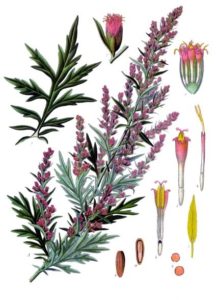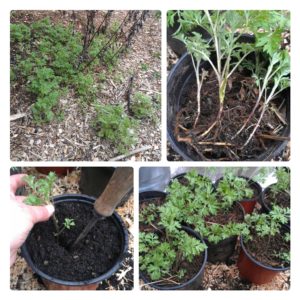14 Mar Mugwort: A Magical Plant
Common Mugwort: Artemesia vulgaris
(Available in our nursery in one gallon size)
It sounds like something from Harry Potter doesn’t it? Well we certainly think it has many magical medicinal properties, and is something you can easily grow in your own food forest! I first found out about it when I visited a local lady spa. There, they have a trough of Mugwort Tea to dump on yourself. It smells heavenly and we were told it’s a topical anesthetic with antibacterial and anti-fungal properties. Naturopaths continue to use the herb as a remedy for disorders of the digestive and reproductive systems. It can also be used to treat intermittent fevers with chills and shivering and is added to healing baths to ease discomfort from eczema, gout and arthritis. Its sage-like, spicy flavor makes a delicious seasoning for meat dishes too. Mugwort also stimulates appetite, promotes good digestion, reduces fevers and relieves tension. When prepared as a tea (to drink), mugwort also provides an excellent source of minerals, especially calcium. Also, you can use it to make ale! What more could you ask for?!
Mugwort is a vigorous grower and can get up to 7 feet tall. It will spread out in a cluster very easily but is also easily maintained. We have quite a few clusters coming up around the mugwort we planted last year in our food forest. So we decided to do a little propagation:
- First, I dug up 2 clumps about 6″ in diameter.
- Second, I filled a few 1 gallon pots with some good 3-way potting soil.
- Third, I used the dandelion weeding tool to create a hole or plug space for the little tap roots to live in.
- Lastly, I watered them in and wah-lah, mugwort for everyone!
 For more information about Mugwort and it’s many uses (including edibility rating) be sure to check out one of our favorite resources.
For more information about Mugwort and it’s many uses (including edibility rating) be sure to check out one of our favorite resources.


